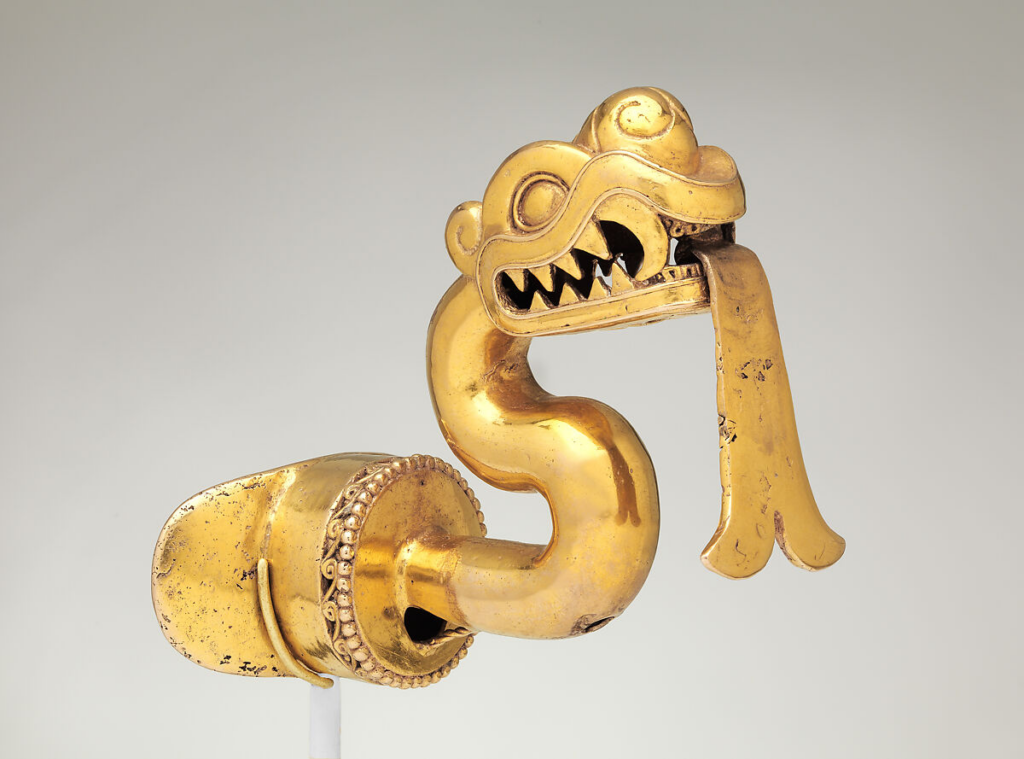In some Cahokian digging sites, archaeologists found maskettes and earrings made to resemble gods. Some archaeologists debate whether Cahokia was influenced by Mesoamerican societies as a lot of their legends and gods have a resemblance to one another. Not only do their gods have a resemblance, but their jewelry does too. So what did Mesoamerican jewelry look like? What did their jewelry symbolize and who could wear what?
Mayan civilization dates back as early as 1500 BCE with agriculture based on maize, squash, beans, and cassava cultivation. Along with a complex agricultural system, Mayans perfected irrigation and even had a complex hieroglyphical system of writing (Britannica.com, 2023). Even though evidence of Mayan civilization can be found around 1500 BCE, evidence of their jewelry can only be dated back approximately 5,000 years. From artifacts found, it seems as though Mayans were the masters of jewelry making. Using materials such as gold, copper, silver, bronze, and jade, their jewelry is just as complex as their agricultural and irrigation systems. Both men and women in Mayan society would wear the same jewelry aside from lip and nose plugs which were typically reserved for men with high social status. One of the most prized and sacred commodities for the Mayans was jade as they saw it as the ultimate symbol of all that is good and holy. They believed that jade represented eternal love. Religion was incredibly important to Mayan civilization which was often reflected in the jewelry they created, especially on jade beads. The Mayan elites would often present jade jewelry as gifts or as offerings to the gods. Jade jewelry would also be used as a prize in Mayan ball games. Overall, Mayans used their jewelry to show their societal status and rank (Cunha, 2021).


Throughout Aztec history, there were strict rules enforced as to who could wear what ornaments. For example, only royalty could wear certain headdresses with gold and quetzal feathers. Leather earplugs were often gifted to warriors who reached high ranks and green earrings with bells were gifted to merchants who participated in a conquest. A higher-status Aztec person would wear more and better quality jewelry than a lower-status Aztec. A wealthy Aztec might wear gold or turquoise earplugs but a lower-class Aztec would wear obsidian earplugs. Both men and women in their society would decorate themselves in bagels, chokers, and necklaces. Overall, though, Aztec jewelry had such variety and the Aztecs really perfected the art of metalworking. Because they prized metalworking so highly, most Aztec jewelry was made of gold and silver, however, they also used feathers, shells, leather, and stones for ornaments (Wikipedia.org, 2023). Bells were a popular style in Aztec society and they were often fashioned to look like little flowers. These bells would often be hung from necklaces or earrings. These metalworkers and craftsmen would dedicate their lives to the craft. Like the Mayans, they would also use religion and symbolism in their jewelry (Aztec-history.com).
References:
- https://www.britannica.com/topic/Maya-people
- https://www.sheilacunha.it/2021/02/03/the-ancient-mayan-jewelry/
- https://en.wikipedia.org/wiki/Aztec_clothing#:~:text=The%20jewelry%20worn%20by%20the,shells%2C%20leather%2C%20and%20stones.
- http://www.aztec-history.com/aztec-jewelry.html#:~:text=Commonly%20used%20materials%20were%20copper,in%20Aztec%20jewelry%20and%20ornaments.
- https://www.atlasobscura.com/places/death-mask-of-pakal-the-great
- https://www.metmuseum.org/art/collection/search/321343
Additional Reading:
- http://www.historyofjewelry.net/jewelry-history/mesopotamian-jewelry/#:~:text=Some%20of%20the%20most%20popular,rings%2C%20amulets%20and%20cylinder%20seals.
- https://hyperallergic.com/483587/jewelry-the-body-transformed-metropolitan-museum-of-art/
- https://nycjewelryweek.com/ishtar-adorned-ancient-mesopotamian-jewelry/

“Throughout Aztec history, there were strict rules enforced as to who could wear what ornaments.” — What does this tell us about the Aztec social hierarchy, and the role of artistic craftsmanship and trade within this unique dynamism?
This tells us that the Aztecs had a strict social hierarchy. Those who were skilled in craftsmanship likely were higher up on this hierarchy as Aztecs valued their jewelry and symbols of social status. Trade was likely highly valued as well as it offered goods to show off social status.